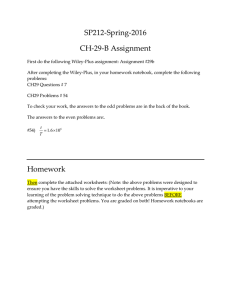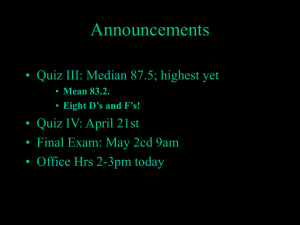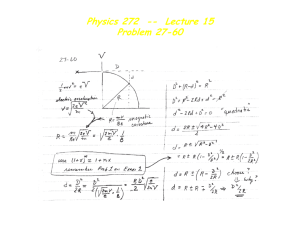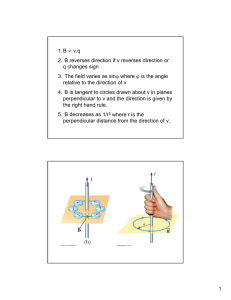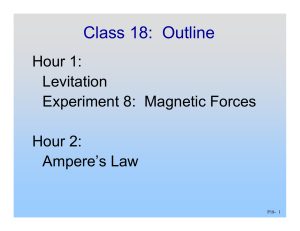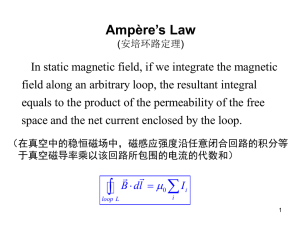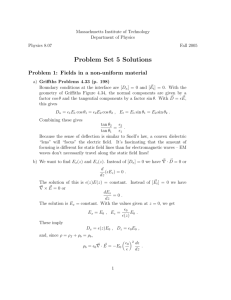3. AMPERE’S LAW
advertisement
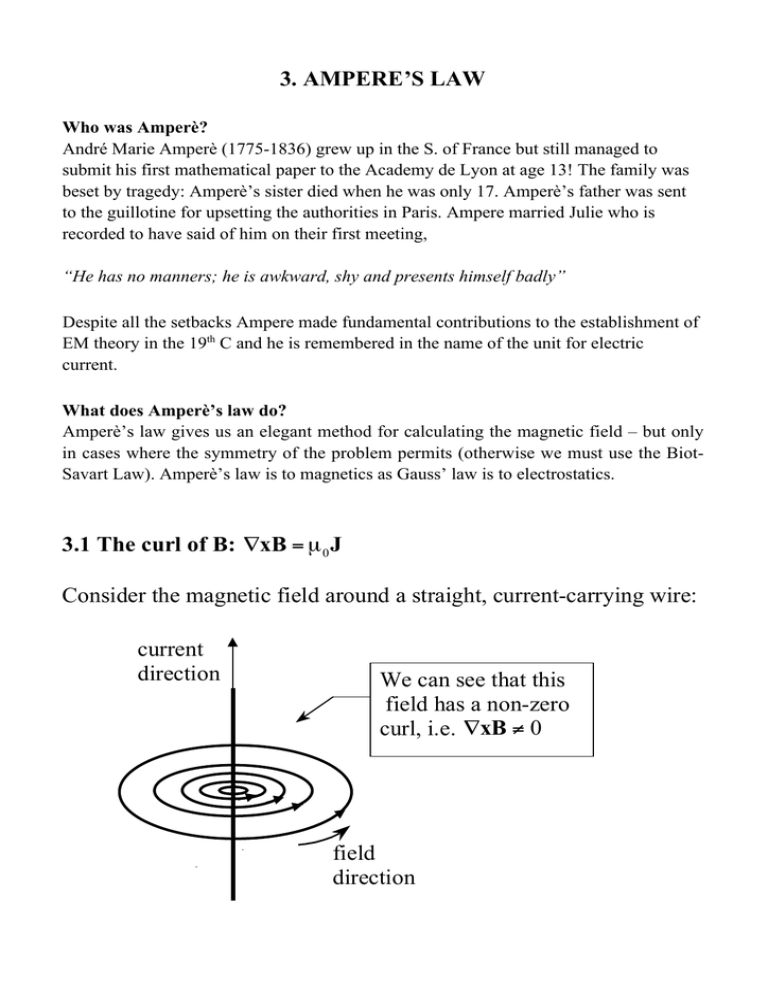
3. AMPERE’S LAW Who was Amperè? André Marie Amperè (1775-1836) grew up in the S. of France but still managed to submit his first mathematical paper to the Academy de Lyon at age 13! The family was beset by tragedy: Amperè’s sister died when he was only 17. Amperè’s father was sent to the guillotine for upsetting the authorities in Paris. Ampere married Julie who is recorded to have said of him on their first meeting, “He has no manners; he is awkward, shy and presents himself badly” Despite all the setbacks Ampere made fundamental contributions to the establishment of EM theory in the 19th C and he is remembered in the name of the unit for electric current. What does Amperè’s law do? Amperè’s law gives us an elegant method for calculating the magnetic field – but only in cases where the symmetry of the problem permits (otherwise we must use the BiotSavart Law). Amperè’s law is to magnetics as Gauss’ law is to electrostatics. 3.1 The curl of B: ∇xB = µ 0 J Consider the magnetic field around a straight, current-carrying wire: current direction We can see that this field has a non-zero curl, i.e. ∇xB ≠ 0 field direction Previously we found (Section 2.2.2(3)) from the Biot-Savart law: B= µ0I 2 πs φ̂ field due to long straight wire unit vector in the azimuthal direction (cylindrical coordinates) In cylindrical co-ordinates dl = s ŝ + dφ φ̂ + dz ẑ , and with I along the z-axis, ∫ B.dl = ẑ = µ0I 1 s dφ 2π ∫ s µ0I 2π dφ = µ 0 I 2 π ∫0 I s = µ0I integration encircles wire once φ̂ direction ∫ B.dl = µ 0 I Amperè’s law in integral form Current enclosed ( I = I enc ) by the Amperian loop If we have a volume current density enclosed (not just a wire carrying current I) we use I enc = ∫ J.da and write Ampère’s law ∫ B.dl = µ 0 I I=Ienc ∫ B.dl = ∫ (∇xB).da I enc = ∫ J.da (Stokes’ theorem) ∫ (∇xB).da = µ 0 ∫ J.da ∇xB = µ 0 J Amperè’s law in differential form We can arrange the closed path of integration to enclose multiple conductors (wires): solenoid I C integration path C loops through 5 turns current passing through surface defined by C = 5I ∫ B.dl = 5µ 0 I 3.2 Applications of Ampere’s law Ampere’s law is useful when there is high symmetry in the arrangement of the conductors. Standard examples are: 3.2.1 B due to a long straight wire: B= µ0I 2 πs s = radial distance from wire (see p226, Example 5.7, Griffiths) 3.2.2 B due to a long solenoid inside solenoid: B = µ 0 nI ẑ outside solenoid: B=0 ( ẑ is along coil axis) n is number of turns per unit length ẑ (see p227, Example 5.9, Griffiths) 3.2.3 B for a short solenoid θΑ At coil centre B = µ 0 nI sin θ A θΑ parameterises the aspect ratio of the coil The field at the ends of a short solenoid is less than B at the centre because the lines of B splay out at the ends At the end of the short solenoid, on axis, we find † B = µ 0 nI θΕ sin θ E 2 Along the solenoid axis the B field profile is, graphically : B 1.5 1.0 0.5 0 centre approximate profile for a solenoid with aspect ratio 5:1 (length is 5x diameter) 0.5 1.0 1.5 † e.g. see p229 Electromagnetism Principles and Applications, Paul Lorrain and Dale Corson, pub. W.H. Freeman and Co., ISBN 0-7167-0064-6. or, P317 Electromagnetic Fields and Waves, Paul Lorrain and Dale Corson, pub. W.H. Freeman & Co., ISBN 0-7167-0331-9. 3.2.4 A more interesting example is the toroid - a ‘doughnut’ shape usually (but not necessarily) with a square or circular cross section (see Fig 5.38, p229, Griffiths). 4. 1. 3. s 2. I current-carrying windings are close wound and continue around the torus, total N turns (only 3 turns are shown) Choice of integration path 1. – 4. ⇒ we can find B-field inside torus, outside torus etc. Along path 2. (inside the torus’ core) Ampère’s law gives 2 πs.B = µ 0 NI s is radius of toroid N is number of turns on toroid B= µ 0 NI 2 πs (B in core of toroid) • Ouside the coil (path 3) B=0 – useful for engineers! (Have a look at these sites to see how useful coils, toroidal transformers etc are.: http://www.toroid.com/rectifier0.htm http://www.audiovideo101.com/dictionary/toroidaltransformer.asp http://www.kinword.com.tw/ (see page 899 Tipler; page 230 of Griffiths for full treatment of the toroid) 3.2.5 Long cylindrical conductor Conductor radius is a . The current I is in the z-direction The current density is J = I πa 2 z I s φ a The cylindrical coordinates of a point in/around the conductor are s,φ ,z in the sˆ φˆ zˆ directions respectively (see Griffiths p43-45 if you can’t remember!) Outside the conductor, i.e. for s > a, B is in the azimuthal direction and is independent of φ (B has cylindrical symmetry). Ampère’s law for s > a gives ∫ B.dl = µ 0 I enc B(2πs) = µ 0 I enc = µ 0 I B= µ0I φ̂ 2 πs (in the φ̂ direction) Inside the conductor, at radius s, we use the current density version of Ampere’s law with J = I πs2 so ∫ B.dl = µ 0 I enc = µ 0 ∫ J.da B(2 πs) = µ 0 J( πs2 ) B= µ 0 Js µ 0 Is = 2 2 πa 2 J = I πs 2 B= µ 0 Is 2 πa 2 inside the wire Graphically, for a 1 mm radius wire carrying 1 amp: B (teslas) s=a 0.0002 1 2 3 4 5 s (millimetres) 3.4 The divergence of B: ∇.B = 0 Taking the Biot-Savart law: B= µ 0 dlxrˆ I 4π ∫ r 2 in the form where we have a volume current J we have: B= µ 0 Jxrˆ 4π ∫ r 2 (p219 of Griffiths) Now, taking the divergence of this ( ∇. ), ∇.B = µ0 Jxr dτ ∇ . 4π ∫ r 2 Using the product rule ∇.(AxB) = B.(∇xA) − A.(∇xB) (this is Product rule #6 inside front cover of Griffiths) we can write Jxrˆ rˆ rˆ ∇. 2 = 2 .(∇xJ) − J. ∇x 2 r r r this term = 0 because ∇xJ = 0 . ∇ operates on field points at ( x, y, z ). Current density J is not a function of ( x, y, z ) but is a function of coordinates ( x ′, y ′, z′ ). To see this, imagine a volume of current dτ ′ = dx ′dy ′dz ′ ; the current density J varies this term = 0 because ∇x r̂ = 0 r2 The vector algebra result ∇x( r n rˆ ) = 0 is well-known – at least by those who know it! Thus, ∇.B = 0 General result: divergence of B=0 always This is one of the two Maxwell equations of magnetostatics (Ampere’s law is the other one). If we use the divergence theorem ∫ ∇.dτ = ∫ A.da we have the equivalent statement ∫ B.da = 0 The net magnetic flux out through any closed surface is zero This tells us there are no magnetic ‘monopoles’ (perhaps we might say, no ‘magnetic charges’) in nature. English physicist Paul Dirac predicted the existence of an ‘antielectron’ or positron (which was discovered in 1932) following his solution of the relativistic Schrödinger equation. Dirac also predicted the existence of magnetic monopoles but these have not been found… If magnetic monopoles existed we would have an equation like Gauss’ law for magnetostatics: ∇.E = ρf + ρ b ε0 Gauss’ law in electrostatics - @ ∇.B α (magnetic charge density) divB ≠ 0 – this is never seen!

